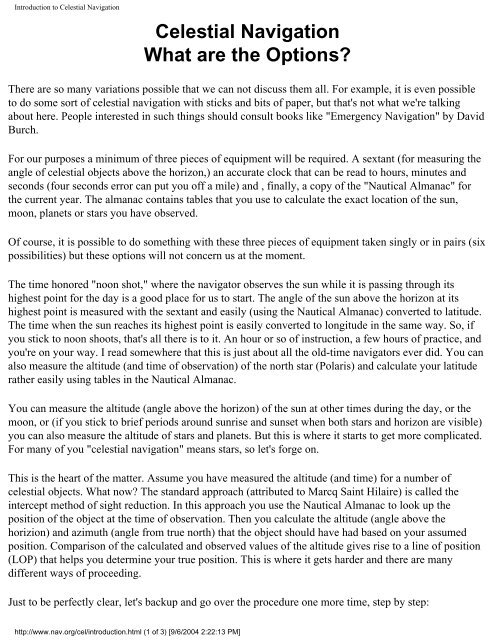Introduction to Celestial Navigation
Introduction to Celestial Navigation
Introduction to Celestial Navigation
Create successful ePaper yourself
Turn your PDF publications into a flip-book with our unique Google optimized e-Paper software.
<strong>Introduction</strong> <strong>to</strong> <strong>Celestial</strong> <strong>Navigation</strong><strong>Celestial</strong> <strong>Navigation</strong>What are the Options?There are so many variations possible that we can not discuss them all. For example, it is even possible<strong>to</strong> do some sort of celestial navigation with sticks and bits of paper, but that's not what we're talkingabout here. People interested in such things should consult books like "Emergency <strong>Navigation</strong>" by DavidBurch.For our purposes a minimum of three pieces of equipment will be required. A sextant (for measuring theangle of celestial objects above the horizon,) an accurate clock that can be read <strong>to</strong> hours, minutes andseconds (four seconds error can put you off a mile) and , finally, a copy of the "Nautical Almanac" forthe current year. The almanac contains tables that you use <strong>to</strong> calculate the exact location of the sun,moon, planets or stars you have observed.Of course, it is possible <strong>to</strong> do something with these three pieces of equipment taken singly or in pairs (sixpossibilities) but these options will not concern us at the moment.The time honored "noon shot," where the naviga<strong>to</strong>r observes the sun while it is passing through itshighest point for the day is a good place for us <strong>to</strong> start. The angle of the sun above the horizon at itshighest point is measured with the sextant and easily (using the Nautical Almanac) converted <strong>to</strong> latitude.The time when the sun reaches its highest point is easily converted <strong>to</strong> longitude in the same way. So, ifyou stick <strong>to</strong> noon shoots, that's all there is <strong>to</strong> it. An hour or so of instruction, a few hours of practice, andyou're on your way. I read somewhere that this is just about all the old-time naviga<strong>to</strong>rs ever did. You canalso measure the altitude (and time of observation) of the north star (Polaris) and calculate your latituderather easily using tables in the Nautical Almanac.You can measure the altitude (angle above the horizon) of the sun at other times during the day, or themoon, or (if you stick <strong>to</strong> brief periods around sunrise and sunset when both stars and horizon are visible)you can also measure the altitude of stars and planets. But this is where it starts <strong>to</strong> get more complicated.For many of you "celestial navigation" means stars, so let's forge on.This is the heart of the matter. Assume you have measured the altitude (and time) for a number ofcelestial objects. What now? The standard approach (attributed <strong>to</strong> Marcq Saint Hilaire) is called theintercept method of sight reduction. In this approach you use the Nautical Almanac <strong>to</strong> look up theposition of the object at the time of observation. Then you calculate the altitude (angle above thehorizion) and azimuth (angle from true north) that the object should have had based on your assumedposition. Comparison of the calculated and observed values of the altitude gives rise <strong>to</strong> a line of position(LOP) that helps you determine your true position. This is where it gets harder and there are manydifferent ways of proceeding.Just <strong>to</strong> be perfectly clear, let's backup and go over the procedure one more time, step by step:http://www.nav.org/cel/introduction.html (1 of 3) [9/6/2004 2:22:13 PM]
<strong>Introduction</strong> <strong>to</strong> <strong>Celestial</strong> <strong>Navigation</strong>1. You measure the altitude of an object (and the time.)2. You calculate the position of the object at the time of observation using the Nautical Almanac.3. You use your assumed position <strong>to</strong> calculate what the altitude should have been and what theazimuth (direction of the object) should have been.4. Comparison of the altitude you measured with the one you calculated gives you an offset that canbe plotted on a chart as a line of position (LOP).5. A "fix" is then obtained by observing where a bunch of LOPs cross.This is the process most people think of when they think of "celestial navigation". Getting it all <strong>to</strong> comeout right requires a fair amount of instruction and practice.At step (3) there are a number of options that we still need <strong>to</strong> discuss. To start with imagine the earth as aglobe with three points marked on it. One point is your assumed position and another is the nearest pole(north or south.) The third point is the geographical position (GP) of the celestial object that youobserved. This GP is the point on the earth directly below the object at the time of observation. You canlook it up in the Nautical Almanac.These three points form the "navigational triangle" and "sight reduction" or "solving the navigationaltriangle" is the process used <strong>to</strong> determine the altitude and azimuth the celestial object would have had ifyou had really been at your assumed position. One way of doing the sight reduction is with aninexpensive hand calcula<strong>to</strong>r (that has "sin" and "cos" keys) using two easy, one line formulas fromspherical trigonometry (You can do it! Trust me.) These formulas can be found (for example) in theNautical Almanac "Sight Reduction Procedures" section under the title "Methods and Formulae forDirect Computation." Another way <strong>to</strong> perform the sight reduction is <strong>to</strong> use tables of pre-calculatedsolutions such as the one given in the Nautical Almanac under the title "Use of Concise Sight ReductionTables."Some people find the "Concise Sight Reduction Table" difficult <strong>to</strong> use and prefer a more accurate andcomplete table known as HO-229. This government publication has the title "Sight Reduction Tables forMarine <strong>Navigation</strong>" and consists of six big, heavy volumes that are a serious problem <strong>to</strong> carry around.These people feel that "real" or "pure" celestial navigation requires that you use HO-229 for your sightreduction. They don't like hand calcula<strong>to</strong>rs and feel that the tables in the Nautical Almanac arecomplicated and perhaps not sufficiently accurate. Most older text books use the HO-229 method. Forexample, my favorite, the well recommended, "Practical <strong>Celestial</strong> <strong>Navigation</strong>" by Susan P. Howell usesHO-229 as does "<strong>Celestial</strong> <strong>Navigation</strong> for Yachtsmen" by Mary Blewitt and "A Star <strong>to</strong> Steer Her By" byEdward J. Bergin. Just add HO-229 <strong>to</strong> the three items mentioned earlier (sextant, clock and NauticalAlmanac) and you have everything you need for traditional celestial navigation.These days there is another popular option in the form of HO-249, the "Sight Reduction Tables for Air<strong>Navigation</strong>." These tables are slightly less accurate than HO-229 and are an interesting hybrid. VolumesII & III are just like HO-229 but they are limited <strong>to</strong> celestial objects whose declination (angle above orhttp://www.nav.org/cel/introduction.html (2 of 3) [9/6/2004 2:22:13 PM]
<strong>Introduction</strong> <strong>to</strong> <strong>Celestial</strong> <strong>Navigation</strong>below the celestial equa<strong>to</strong>r) is less than 29 degrees. This is good enough for the sun, moon, planets andsome stars. Volume I is something completely different. It has the sub-title "Selected Stars." Each day achanging set of seven stars (out of the 41 best navigation stars) are presented in a way that combines thefunctions of the almanac and sight reduction tables. It even suggests the 3 best stars in each case.Most modern books on celestial navigation are based on the use of HO-249. Some good examples are"<strong>Celestial</strong> <strong>Navigation</strong> by HO-249" by John E. Milligan, "One-day <strong>Celestial</strong> <strong>Navigation</strong>" by Otis S.Brown or "Miranav" by Rosalind Miranda. Of course, if you have taken a course based on the traditionaluse of HO-229 it is easy <strong>to</strong> switch. I usually teach HO-229 because I have found that many people want<strong>to</strong> learn the most traditional possible form of the subject, but I'm thinking of switching <strong>to</strong> HO-249because it is so similar (and there are fewer volumes <strong>to</strong> lug around).Finally, let me mention my own favorite form of celestial navigation. The "Celesticomp V" handcalcula<strong>to</strong>r. This little jewel will run your DR (dead reckoning) track for you and use it as your assumedposition. It contains the celestial object positions so no almanac is required. You just punch in yourobservations (object code, altitude and time) and out comes a LOP. It will even combine LOPs in<strong>to</strong> a fixand then start your new DR track from the fix. It's great. I enjoy making the observations and plotting theresults more than I enjoy all the paperwork of looking things up in the Nautical Almanac and SightReduction Tables, so this works great for me. Of course, the real fun is being able <strong>to</strong> do it all andknowing different ways <strong>to</strong> do each thing. For example, I sometimes use a hand calcula<strong>to</strong>r method called"Sumner's Lines" that gives a LOP from quite a different approach than the usual method.The equipment I use consists of an Astra IIIB sextant, which is without question the best deal aroundconsidering its high quality and relatively low price. I have attached a small digital clock <strong>to</strong> the sextantand I carry the sextant in a small foam lined high impact plastic case that can take a <strong>to</strong>n of pressure or a 7foot drop (and it floats). There is also space in the case for my Celesticomp V calcula<strong>to</strong>r, my handcalcula<strong>to</strong>r, an electronic handbearing compass and a copy of the current Nautical Almanac. With thisarrangement there is a substantial amount of redundancy and everything is in one place.Bill Myerswww.nav.orgmyers@nav.orghttp://www.nav.org/cel/introduction.html (3 of 3) [9/6/2004 2:22:13 PM]
Homepage for Bill MyersWilliam D. Myers (Bill)● The primary reason for this website is <strong>to</strong> provide aplace for me <strong>to</strong> share material concerning my interests insailing and celestial navigation.● I'm retired now, but for about 35 years I worked at theLawrence Berkeley Labora<strong>to</strong>ry on a scientific programconcerning the properties of nuclei.● My wife Valerie and I have started a occasionalnewsletter <strong>to</strong> keep friends up <strong>to</strong> date on our adventures.Valerie has also started her own web page.Search this sitepowered by FreeFindhttp://www.nav.org/ [9/6/2004 2:22:22 PM]














